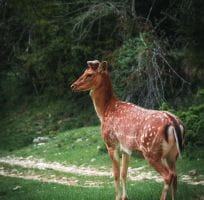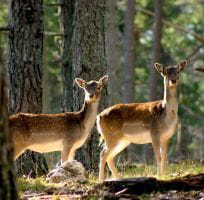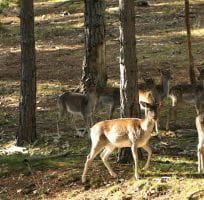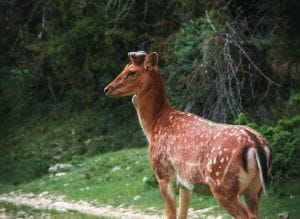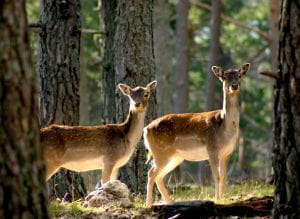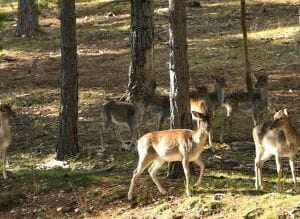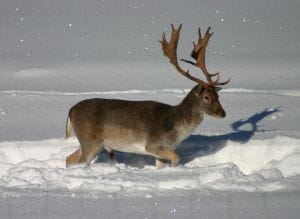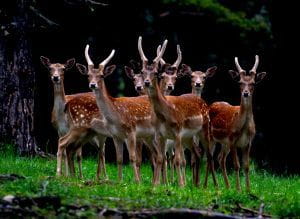Fallow deer
Dama dama
This deer is quite surprising. When it comes to clothing, he follows fashion. In summer, its coat turns red and is speckled with white, making it look like a fawn, the young of the doe. In autumn, the coat turns dark brown and the spots fade.
The antlers have nothing to do with those of the stag, they’re more like those of the elk: they’re flat and webbed, facing forward. Weighing around 5.5 kilos, they fall off between April and May, before growing again around June. In three months, these antlers can reach 90 centimetres in length. Just in time to take on its sex-hungry competitors.
The fallow deer’s hearing and sense of smell are highly developed. On the other hand, its night vision isn’t very good and forces it, unlike the deer, to be much more active during the day.
The fallow deer’s hearing and sense of smell are highly developed.
The history of the European fallow deer
According to Pascal et al., 2006, fallow deer were widespread in Europe before the last ice age (-60,000 to -10,000 BC). The species disappeared from Europe 10,000 years ago (probably for several reasons, including the development of agriculture and hunting because its meat was highly prized). It was reintroduced from extant populations in Asia Minor (present-day Turkey) from the Bronze Age onwards (around -2,000 BC), and then in Roman antiquity.
This is the first time that this species has been reintroduced in Europe.
In France, remains are found in Marseille, in deposits dated from the 3rd to the Vᵉ century, and in the north of the country, in deposits ranging from Antiquity (beginning in -3,000 BC) to the High Middle Ages (end around the Xᵉ century). During the late Middle Ages (around the XIVᵉ / XVᵉ century) and the Renaissance (from the XVᵉ to the XVIIᵉ century), populations were maintained in royal and seigneurial hunting parks. Today’s French populations are thought to have originated in these parks. During the Renaissance, fallow deer were considered noble and domesticable animals. Roe deer (small and very numerous) are for the People, fallow deer (“pretty” with their white spots and rarer) are for the Nobility and stags (“majestic” with their antlers) are for the King’s Court.
In 2013, 53 French départements count fallow deer in their forests, with the largest populations in eastern France. Scientific hypotheses (as yet unproven) suggest that fallow deer virtually disappeared in France after the Second World War, and that today’s wild fallow deer populations are mostly the result of escapes from private parks. Fallow deer do not compete with red deer (Cervus elaphus), but are said to have a negative impact on roe deer (Capreolus capreolus) populations.
Species ethology
Deer practice sex separation, except during the mating season in October. Herds of males on one side, herds of females on the other. Females are usually accompanied by their youngest offspring, and sometimes by their previous fawns (the word is used for all cervids). Young males leave their mothers at 18 months.
This kind, peaceful life comes to an end in October when the males’ virility awakens. Everyone tries to build up the most well-stocked harem. The rutting season lasts roughly a month, from mid-October to mid-November.
The rutting season lasts roughly a month, from mid-October to mid-November.
The females join the males during the breeding period, known as the rut, when, as with the Elaphe Deer, the male fallow deer will “bellow” in the forest to call the female. If the stag is “bellowing”, the fallow deer is said to be “roaring”. The dominant male chooses a territory for himself, which he demarcates with his urine and by rubbing his antlers on tree trunks.
In forested areas where surveillance is more complicated, the male is content with a few daines, while in open grassland he may reserve around thirty partners for himself. As with red deer, courtship techniques are adapted to the circumstances. Some males prefer to defend their territory, waiting for one or more daines to step up to the plate, while others take their future wives by landing on their competitor’s territory. As with deer, fallow deer fight, antler to antler, to attract as many daines as possible and maximize their chances of having offspring.
The victor must now honor all his females so proud of their hero. For each one, he frequently has to set the table again to be sure of future paternity. Needless to say, it takes a lot out of him. Between watching over his females and his sexual activities, which hardly leave him time to eat, the fallow deer can lose a third of his weight
After an 8-month gestation period, the fallow deer isolates herself to give birth in late spring to one fawn, much more rarely to two. (Fawn is the generic term for all cervid offspring)
Young males leave their mothers at 18 months, while young females form close-knit family groups with their mothers.
Their antlers grow in late spring to mid-summer and fall off early the following spring.
A funny opportunist
The fallow deer is a species capable of adapting to almost any environment. The heat and dryness of the Mediterranean rim doesn’t scare it any more than the snow and cold of Scandinavia. As long as there’s plenty to graze on! Essentially herbivorous, it gobbles up all the herbaceous plants found in undergrowth and meadows. This doesn’t stop it from enriching its menu with young shoots, leaves, twigs of deciduous and semi-woody trees, and even the bark of many tree species. So it’s hardly surprising that it’s an undesirable species in most of France’s forested regions! The fallow deer’s appetite doesn’t stop there. It enjoys acorns, chestnuts and all kinds of wild berries. Its presence is even regularly attested in Alsatian orchards.
A remarkable arrival
To complete the biodiversity of our Reserve, it was absolutely necessary to introduce fallow deer. This was achieved in October 2019, when 4 females and 1 male arrived from the Czech Republic. It wasn’t shyness that stifled these newcomers. It was not shyness that stifled these newcomers, but their belligerent nature that immediately imposed itself on the much larger stags.
Our male deserves a lot of credit.
Our buck well deserves his nickname Attila! Much less shy than his female companions, he remains easy to observe on our safaris.
Our male deserves his nickname Attila!
During the winter of 2019-2020, the four inquisitive daines explored the entire Reserve territory. They could be observed until the end of May when they abruptly disappeared. What could have been the reason? We can only imagine… the future mother prefers discretion.
A Fertile Spring
Effectively on June 29, 2020, a small head appeared behind a boxwood bush. The Reserve’s first fallow deer fawn! To our surprise, this birth was followed by three more. All the daines had given birth!
They remained discreet throughout the summer, hiding their young in the bushes, then from mid-October onwards, they began to move about in herds, in the meadows and undergrowth.
Did you know?
- There is another fallow deer on Earth, considered by some to be a species in its own right and by others to be a subspecies of Dama dama (our European fallow deer).
The Mesopotamian fallow deer (or Persian fallow deer), Dama mesopotamica, has long been considered an extinct species. It is one of the rarest and most endangered cervids. Its original range is thought to be from Tunisia to Iran (west to east) and from Kuwait to Georgia/Armenia (south to north). - Japanese Fallow Deer is often referred to! In particular, the “Nara Fallow Deer” is very present in forest parks in Nara (near Kyoto and Osaka). But Japanese fallow deer aren’t fallow deer at all! They’re Sika deer (Cervus nippon), another cervid species, with a spotted phenotype in Nara.
- Finally, fallow deer are the emblem of Rhodes. Legend has it that the island’s inhabitants imported them to ward off poisonous snakes. Indeed, before their arrival, more Rhodians succumbed to snakebite than to war. In gratitude, at the entrance to Mandraki harbor, 2 stone columns adorned with bronze statues were built, one representing a fallow deer, the other a dane. In place of the famous Colossus!
